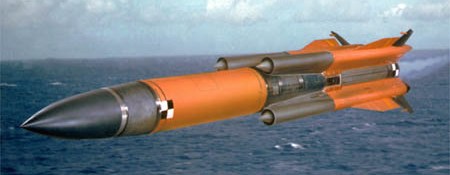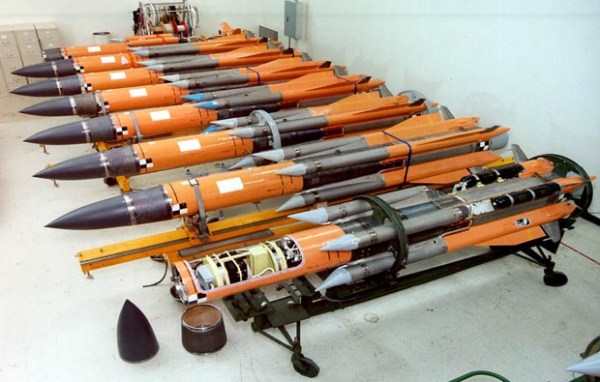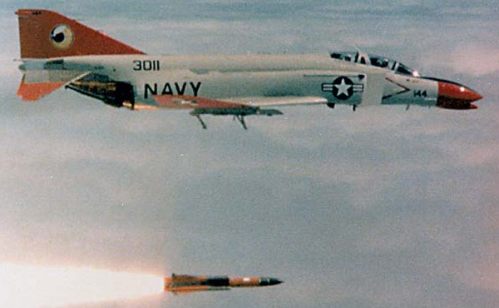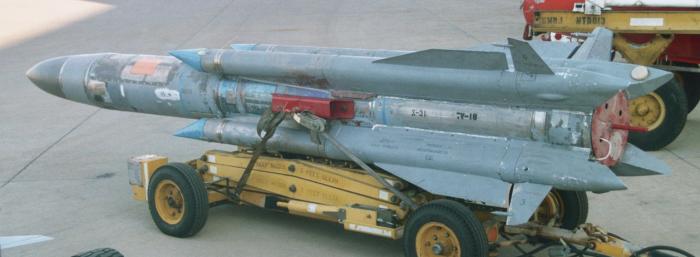Boeing/Zvezda-Strela MA-31 (original) (raw)
After the Navy had cancelled the AQM-127 SLAT (Supersonic Low-Altitude Target) program in 1991, it used residual funding to continue low-key studies for alternative supersonic expendable low-altitude targets. In May 1995, McDonnell Douglas received a contract for an FCT (Foreign Comparative Testing) program, which would evaluate a version of the Russian Zveda-Strela Kh-31A missile as a target drone.
 |
|---|
| Image: Boeing |
| MA-31 |
The Kh-31A was a high-speed active radar guided air-launched anti-ship missile known to the NATO as AS-17 Krypton. It was powered by an integrated solid-fueled rocket/ramjet propulsion system. After burnout of the rocket, the covers on the four ramjet intakes were jettisoned, and the empty rocket case served as the ramjet's combustion chamber. The missile could reach speeds of Mach 3.1 at high-altitude and Mach 2.5 at sea level. The Kh-31A airframes for the target conversions were delivered by Zvezda-Strela to Boeing (formerly McDonnell Douglas) without warhead and other military equipment, and the American contractor then installed a tracking beacon, telemetry and flight termination systems. The target drone variant was designated as MA-31 and first flew in August 1996.
 |
|---|
| Photo: Boeing/U.S. Navy |
| MA-31 |
The Navy's evaluation of a total of 13 MA-31s continued until 1998/99. A competitor of the MA-31 was the Honeywell (Allied Signal)Sea Snake, an advanced derivative of the old MQM-8G Vandal. In December 1999 Boeing won the competition and received a contract for a small batch of 34 MA-31 targets.
 |
|---|
| Photo: Boeing/U.S. Navy |
| MA-31 |
However, the MA-31 was only an interim solution, because the drone lacked the range and flight path accuracy to fully satisfy the Navy's SSST (Supersonic Sea-Skimming Target) requirement for the simulation of a high-speed anti-ship missile. During the MA-31 evaluation, Boeing had demonstrated an improved variant (sometimes called MA-31PG; PG = "Precision Guidance") with a GPS-based navigation system and the resulting option for a precise flight path after a high-altitude (and therefore longer range) launch, but in the end this variant was not selected for production as the ultimate SSST. Instead, that contract went to Orbital Sciences in June 2000, leading to the GQM-163 Coyote SSST. After the GQM-163 became operational, the remaining MA-31 targets were expended until the end of 2007 and the program terminated.
 |
|---|
| Photo: Kaston/Skyshadow |
| MA-31 |
Specifications
Note: Data given by several sources show slight variations. Figures given below may therefore be inaccurate!
Data for MA-31 (except where noted):
| Length | 4.70 m (15 ft 5 in) |
|---|---|
| Wingspan | 1.15 m (9 ft 9.3 in) |
| Diameter | 36 cm (14.2 in) |
| Weight | 600 kg (1300 lb) |
| Speed | Mach 2.5 |
| Range | 50 km (27 nm) (Kh-31A from high-altitude) |
| Propulsion | Solid-fueled integrated rocket/ramjet |
Main Sources
[1] Kenneth Munson (ed.): "Jane's Unmanned Aerial Vehicles and Targets, Issue 15", Jane's, 2000
[2] Boeing Website
[3] William Leque: "Team MA-31 sees successful launch", August 2002
Back to Directory of U.S. Military Rockets and Missiles, Appendix 4
Last Updated: 4 December 2008